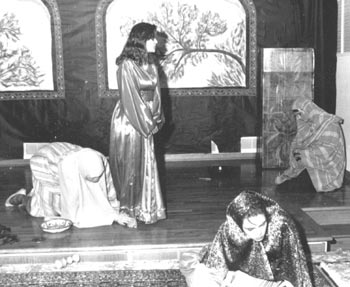| Poetry | Iran | ||||||||||||||||||||||||||||||||||||||||||||||
BAFA © 2010. All material here is copyrighted. See conditions above. |
Táhirih
|

There are no known photographs of Táhirih. This is painting of how Táhirih could have looked. Titled Táhirih composing
poetry, it is painted by Pooria Sabetazm, U.S.A.
Oil on Canvas, 153 B.E., 1996, 14 x 16 inches. "Finding inspiration in the courage and audacity of Tahirih, I painted several paintings documenting her life. It is my hope that paintings of Táhirih will bring attention to the role which the Bahá´í Faith has played in paving the way for the equality of men and women. These paintings are based on the descriptions given by Nabil in The Dawnbreakers." |
Born: Fátimih Zarrin Taj Baraghani Umm-Salamih in Qazvin. The 17th "Letter", she is a poet and translated some of The Báb's writings into Persian. Táhirih (meaning 'the pure'), is the name given to her by the Báb. She was also known as Qurrat al-'Ayn (meaning 'solace of the eye').
|
 Scene one, The women's quarters in the home of Mullá Tagi Qazuin, Perisa, from Táhirih, a play in 3 Acts (12 Scenes)
Scene one, The women's quarters in the home of Mullá Tagi Qazuin, Perisa, from Táhirih, a play in 3 Acts (12 Scenes) by Carolyn Nur Wistrand. Performed at University of Indiana-Bloomington, International Bahá´í Youth Conference, 1988 & the University of Michigan-Flint, 1988. |
“Holding regular gatherings… she spoke to large audiences from behind a curtain. In the inner quarters she also held classes for women. Her personality, theological knowledge, and mastery of Arabic impressed Arabs and Persians alike… The Qurratiya, as her followers came to be known in Iraq, were successful in transmitting her message to the Shi'ite public beyond Karbala, thus causing excitement... and anxiety for the Shaykhi and Usuli leaders alike... (Her) debate was based on Shaykhi ideas, but with a distinct messianic overtone... The fact that she had her own views contradictory to the Islamic law and legal injunctions, combined with the fact that she adopted certain ascetic practices like devotional prayers, and eschewing meat and cooked food, underscores her independent religious stance. Clearly, her commitment to the Báb provided her with a framework... The surviving examples of Qurrat al-Ayn's works from this period testify to her skill in making use of the Qur'an and hadith for arguing the theme of progressive revelations..." (Resurrection and Renewal, by Abbas Amanat, Cornell University Press, U.S.A., 1989, pages 300 - 303, ISBN: 0-8014-2098-9) |
Copyright of all work is with the artist concerned. |
Arts Dialogue, Dintel 20, NL 7333 MC, Apeldoorn, The Netherlands email: bafa@bahai-library.com |